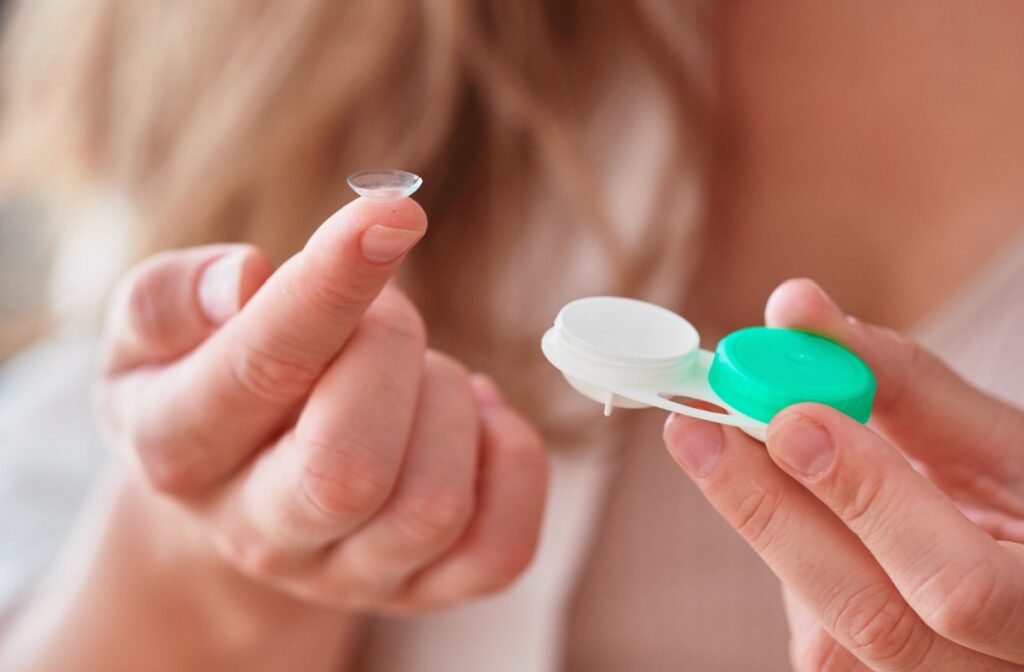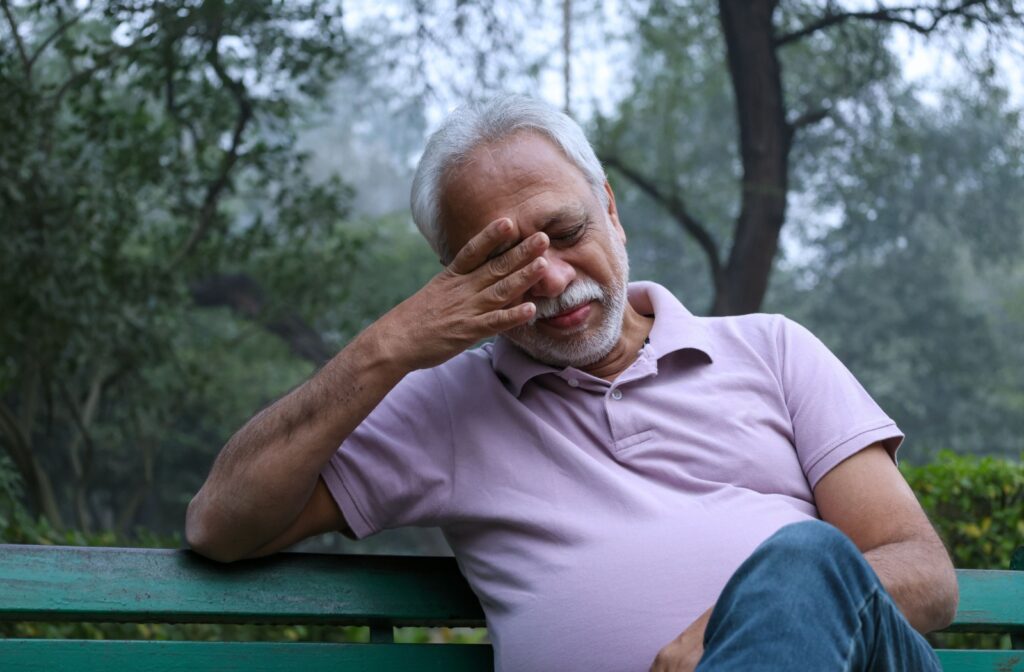If you wear contact lenses and experience scratchy, uncomfortable eyes, you’re not alone. Individuals who wear contact lenses are at a higher risk of developing dry eye disease. This condition can cause unpleasant symptoms, such as redness, blurry vision, or the sensation that something is stuck in your eye.
If you’re experiencing symptoms of dry eye disease and wear contact lenses, talk to your optometrist. There are ways we can manage dry eye disease associated with contact lenses.
What Is Dry Eye Disease?
Dry eye disease happens when a person doesn’t produce enough tears or when the tears they produce are of an inadequate quality.
People tend to produce fewer tears as they age, and certain environmental conditions can make our tears evaporate too quickly. This can lead to symptoms of dry eye. Our tears are composed of 3 layers: oil, water, and mucus. When these components are out of balance, dry eye symptoms can develop.
People who wear contact lenses are at greater risk of experiencing dry eye disease. Other risk factors for this condition include:
- Age and gender: Older people and women are more likely to experience dry eye disease. People produce fewer tears as they get older, and hormonal changes can contribute to dry eye disease, too.
- Medications and underlying conditions: Some drugs, including antihistamines, antidepressants, and decongestants, may cause dry eyes as a side effect. Certain health conditions, such as diabetes and rheumatoid arthritis, are also linked to dry eye symptoms.
- Environmental exposures: Being in the presence of dry eye triggers like wind, smoke, and low-humidity spaces can raise your risk of dry eye disease.
If you have dry eye disease, you’re not alone. According to the National Eye Institute (NEI), the condition affects nearly 16.4 million Americans. Dry eye disease symptoms include:
- Fuzzy vision
- Stinging and scratchy sensations
- The feeling that there’s something stuck in your eye
- Redness
- Excessive tears
- Sensitivity to light
- Sticky discharge
Can Contacts Cause Dry Eyes?
Contact lens wear is indeed a risk factor for developing dry eye disease.
Contact lenses are corrective lenses that sit directly on the surface of your eye, and they can separate the oily and watery layers of your tear film. This can affect tear film stability, thin out the tear film, and increase friction on the eye’s surface, contributing to discomfort.
Do Contacts Dry Out Your Eyes?
The wearing of contact lenses is also associated with the dysregulation of proteins in the eye that support lubrication.

Are Daily Contacts Better for Dry Eyes?
They may be worth a try. Disposable lenses designed to be used once may be less prone to protein deposits collecting behind the lens. Daily disposable lenses are also generally made of silicone hydrogel. This material has a higher water content, but it’s also prone to drying out quickly.
Everyone’s eyes are different. We recommend discussing your contact lens needs and preferences with an optometrist who is experienced with treating dry eye disease.
What Other Types of Contact Lenses are Recommended for Dry Eye?
Scleral lenses are sometimes an alternative to standard contact lenses. This type of contact lens sits on the sclera (the white part of your eye) rather than the cornea. The lenses leave a space between the lens and the cornea that can hold fluid against the surface of the eye.
How Can I Manage Dry Eye Disease at Home?
Sometimes, simple lifestyle changes can help alleviate symptoms of dry eye disease. Ideas include:
- Managing screen use: One possible option is to adjust how you view screens. Ideally, set up your screen so that it is 35 inches away at a downward angle of 10 degrees. Adopting the 20-20-20 rule can also help: look at an object 20 feet away for 20 seconds every 20 minutes.
- Getting enough rest: Adults should aim to sleep 7 to 9 hours a night. Sleeping fewer than 7 hours a night is linked to more health problems.
- Staying hydrated: Your hydration needs depend on factors like age and activity level, but aiming for 8 glasses a day is a good rule of thumb. Ideally, hydrate with water, but juice, tea, and watery fruits and vegetables also help.
What Other Options are Available for Treating Dry Eye Disease?
Many options are available to address dry eye disease symptoms. These include:
- Punctal plugs: These are small devices inserted into the tear ducts to prevent tears from draining too quickly.
- Intense pulsed light therapy: This in-office procedure involves using light pulses to unblock clogged meibomian glands, which are responsible for producing the oily layer of your tear film.
- Eyelid care: Many people with dry eye disease also experience blepharitis, which is inflammation of the eyelid. Cleansing the eyelids of debris that may block the meibomian glands can address dry eye symptoms.
Experienced Dry Eye Treatment in Surprise, AZ
Dry eye disease is more than a frustrating inconvenience. It can significantly impact a person’s productivity and quality of life. Moreover, severe, untreated dry eye disease can damage your cornea.Visiting an optometrist can help. West Valley Dry Eye is passionate about helping individuals who are experiencing dry eye disease. We offer a variety of treatment options for dry eye, including intense pulsed light therapy, punctal plugs, eyelid cleansing, and more. To take a step towards finding relief, book an appointment with us today.


